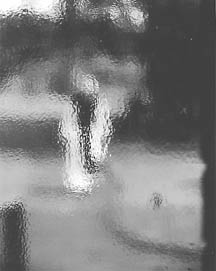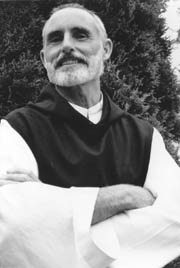THROUGH A GLASS DARKLY
Trappist monk connects with the world through a camera lens
By Chris Webb
A man that looks on glass,
On it may stay his eye;
Or if he pleaseth, through it pass,
And then the heaven espy.
-George Herbert (1593-1633) British poet/clergyman

An as yet untitled photograph bt Brother Paul Quenon
Through large metal doors, under a concrete wall embedded with the words "God Alone," walks Brother Paul Quenon. He's lived here, at the Abbey of Gethsemani near Bardstown, since 1958 when he was only seventeen years old. This is his home. With a well-trimmed beard of gray and eyes that put you completely at peace, the Trappist monk smiles and leads the way. His customary hooded robe blowing in the wind, he strolls past a beautiful pond and countless flowers and decides to take a seat under a shady tree. He folds his hands, smiles again, and relaxes to discuss his love for photography and an upcoming exhibit in which his works will be featured.
The roots of Quenon's fondness for taking pictures are numerous. But one interesting source goes back many years. Soon after entering the monastery, Quenon studied for two years as a novice under the renowned spiritual writer and fellow monk Thomas Merton, who also loved taking pictures. On one particular occasion, Merton gave Quenon a book to look at. In it were paintings by the German bauhaus painter Paul Clay. Already interested in art from an early age, Quenon studied the book and absorbed all he could, being particularly drawn to the use of form.
That interest in form stuck with Quenon and over the years, he developed quite a keen eye for composition and structure. And though he was always interested in looking at photography, it wasn't until 1980 that Quenon actually got ahold of a camera to play around with.
"In 1980," Quenon says, "I went to Nigeria to help with a new monastery there. I took the camera along just for snapshots. But I also found as I used it that I had some nice results, artistically speaking. When I returned, the abbot let me keep the camera and I've been using one ever since."
Experimenting for years with black and white film, Quenon did much of his own processing. He gained a deeper understanding of photography and his style began to take shape. His pieces were mostly photographs of two dimensional surfaces. But in the last few years, Quenon's style evolved a bit and he began to investigate with alternate types of photographic expression, specifically by using color and by altering images through glass.
"In recent years," explains Quenon, "I've started to use more color. I'm not really so much interested in color as I am in form. Form is the thing that really interests me. And color just goes along with that. The simpler the colors the better. The fewer the colors the better. For example, I was recently at the Maker's Mark Distillery. They have these huge black buildings, which are interesting in themselves. But as I looked at them, I got more interested in the details. There was a door which had a lock on it and the lock was covered with a flap, which had an interesting triangular shape. The door was painted black, but the paint had worn away in spots and you could see red under the surface. So these two colors in addition to the wonderful forms made for a stunning photograph."
Photo by Kevin Wilson
Quenon continues, "I suppose looking at abstract art helped lead me to that sort of interest in forms. But in the last few years I've been interested in glass. Glass can modify the scene, especially if it's dirty glass with water stains on it or thicker hammered glass. They fragment the color as it's coming through, giving the image an impressionistic effect. Textured handmade glasses will warp shapes. You have to experiment to figure out just how to focus. But at a certain focal point, the glass will split lines, double them, triple them, blur them, make straight lines wavy, and generate a very painterly effect. Some people have said, 'Oh, I love your paintings.' I have to tell them that they're not paintings at all. They're photographs."
To further enhance his pictures, Quenon gives each one a name. An accomplished poet as well as a photographer, he loves to work with words.
"I think for a long time before I name a photograph,' Quenon states. "Generally, I let the photograph suggest itself. Sometimes the name is just an interesting word, or it might have an interesting sound. I think you can deepen the perception of the picture by giving it a good name."
Coming up with a good name for their joint exhibit, Quenon and friend/fellow artist David Kocka decided on the theme "Through a Glass Darkly."
"It's taken from a passage from Saint Paul," states Quenon. "David suggested it. But when I thought about it, I realized that it corresponds not only with the use of glass in my photographs, but with what I've really been doing with my art in general, that is, to give some sense of the mystical dimension of reality."
Giving a quick glance to his surroundings, Quenon begins to expound on this mystical dimension. "We see things around us all the time. But I want to be able to see them a certain way. I want to be able to see them through the eyes of a contemplative, someone who's looking for a deeper aspect. I guess that's suggested by my use of glass in my photographs as well. You see, it's about slowing down and letting reality be present to you so you can perceive it in the fullness of its being. By seeing a piece of reality, you can see the totality. For instance, I've been told that this one picture I took of a wall and a window suggests the entire monastery as a whole. A good photograph can do that. It can communicate a sense of place, or a feeling for a place."
Having sold his photography all over the country and been involved in numerous photo shows, Quenon has visually connected with lots of people, people who are deeply affected by the composition and beauty of his pictures.
But Quenon is remarkably humble about the impact his pictures have had on people. He says, "With photography, like many arts, there's a lot of the accidental taking place. Many times, when I look at one of my photos, I see lots of things that I didn't even see when I originally took the photo."
However they are perceived, Quenon's pictures are a way of connecting and sharing with other people. "Normally," explains Quenon, "I just see something and think, 'Wouldn't it be nice if other people could see this?' For me, it's about sharing a vision. I think of a picture as a living thing. And life is meant to be shared."
Brother Paul Quenon's photography exhibit will be held at the Glendale Gallery in Glendale, OH, just north of Cincinnati, in the Village Square. The show opens on June 18th, from 5-7, and will remain at the Glendale Gallery for a month as a joint exhibit with David Kocka, a sculptor and painter.